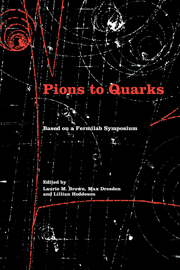Book contents
- Frontmatter
- Contents
- List of contributors
- Foreword by Leon M. Lederman
- Editors' acknowledgments
- Photographs of the symposium
- List of abbreviations
- List of notation
- I Introduction
- II Particle discoveries in cosmic rays
- III High-energy nuclear physics
- IV The new laboratory
- V The strange particles
- VI Weak interactions
- VII Weak interactions and parity nonconservation
- 29 The nondiscovery of parity nonconservation
- 30 K-meson decays and parity violation
- 31 The τ–θ puzzle: an experimentalist's perspective
- 32 The early experiments leading to the V–A interaction
- 33 Midcentury adventures in particles physics
- VIII The particle physics community
- IX Theories of hadrons
- X Personal overviews
- Name index
- Subject index
33 - Midcentury adventures in particles physics
Published online by Cambridge University Press: 07 May 2010
- Frontmatter
- Contents
- List of contributors
- Foreword by Leon M. Lederman
- Editors' acknowledgments
- Photographs of the symposium
- List of abbreviations
- List of notation
- I Introduction
- II Particle discoveries in cosmic rays
- III High-energy nuclear physics
- IV The new laboratory
- V The strange particles
- VI Weak interactions
- VII Weak interactions and parity nonconservation
- 29 The nondiscovery of parity nonconservation
- 30 K-meson decays and parity violation
- 31 The τ–θ puzzle: an experimentalist's perspective
- 32 The early experiments leading to the V–A interaction
- 33 Midcentury adventures in particles physics
- VIII The particle physics community
- IX Theories of hadrons
- X Personal overviews
- Name index
- Subject index
Summary
It was in the spring of 1952 that I joined the Tata Institute of Fundamental Research (TIFR) as a student. The shining light in theoretical research was Homi Bhabha, who had then completed his work on cosmic-ray cascades and relativistic wave equations. Bhabha was deeply involved in organizing a nuclear research team in Bombay, but he was still very much the academic leader and presided over the weekly colloquia. He also brought to Bombay many distinguished physicists, like Paul A. M. Dirac, Maria Goeppert-Mayer, Maurice Levy, Robert Marshak, Joseph E. Mayer, Abraham Pais, Wolfgang Pauli, and Sin-itiro Tomonaga, and he convinced Bernard Peters to join the TIFR faculty. I worked with Peters, and I quickly graduated from developing and scanning nuclear emulsions to developing theoretical aspects of experimental particle physics. Several τ mesons were discovered in our laboratory; for myself, I began to study in detail Richard Dalitz's paper on τ decay analysis.
Enrico Fermi's thermodynamic model and Werner Heisenberg's shockwave model of multiple meson production were of great interest at TIFR. A large “star” was discovered in an emulsion stack; the study of the distribution and interaction of secondaries was among my first lessons in particle physics. But all this time the glamour topics were relativistic wave equations and quantum theory of higher-spin fields.
During my second year in Bombay, Marshak came to lecture at TIFR and told us about the Chicago experiments on pion–nucleon scattering and the 3-3 resonance. This was the beginning of an association that has had a decisive effect on my scientific career.
- Type
- Chapter
- Information
- Pions to QuarksParticle Physics in the 1950s, pp. 485 - 494Publisher: Cambridge University PressPrint publication year: 1989



